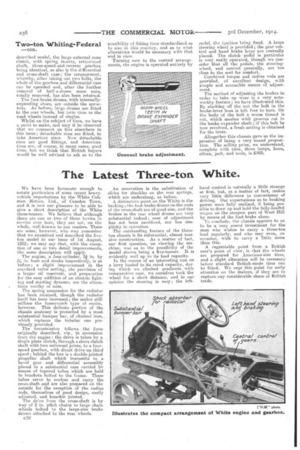The Latest Three-ton White.
Page 14

If you've noticed an error in this article please click here to report it so we can fix it.
We have been fortunate enough to ontain particulars of some recent heavyvehicle importations by the White Cole man Motors, Ltd., of Camden Town, and it is now our pleasure to be able to give a short description of the White three-tonner. We believe that although there are one or two of these lorries in service over here, they are not, on the whole, well-known to our readers. There are some, however, who may remember that we examined and described the five-ton model in our issue of lst August, 1912; we may say that, with the exception of one or two detail improvements, the same description will apply. The engine, a four-cylinder, 3i in. by _4 in. bore and stroke respectively, is as before; a slight improvement in the standard valve setting, the provision of a larger oil reservoir, and preparation for the easy addition of an electric lighting and starting dynamo, are the alterations worthy of note.
The spring suspension for the radiator has been retained, though the radiator itself has been increased; the maker still utilizes the honeycomb type of cooler, however. This delicate portion of the chassis anatomy is protected by a most substantial bumper bar, of channel iron, which replaces the tubular one previously .provided.
The transmission follows • the lines -originally described, viz., in succession from the engine : the drive is taken by a single plate clutch, through a short clutch shaft with two universal joints, to a fourspeed gearbox, with direct drive-on third speed ; behind the box is a double-jointed propeller shaft which transmits to a bevel gear and differential accessibly placed in a substantial case carried by means of tapered tubes which are held in brackets bolted to the frame. These tubes serve to enclose and carry the cross-shaft and are also prepared on the -outside for the reception of the radius rods, themselves of good design, easily adjusted, and knuckle jointed.
The drive from the cross-shaft is by way of 2 in. pitch chains to large chain wheels bolted to the large-size brake drums attached to the rear wheels.
e20
An innovation is the substitution of slides for shackles on the rear springs, which are underslung, as before.
A distinctive point on the White is the braking ; the foot-brake drums on the ends of the cross-shaft are of good size, and the brakes in the rear wheel drums are very substantial indeed; ease of adjustment has not been sacrificed, nor has simplicity in operation. The outstanding feature of the threeton chassis is its substantial, almost massive construction. As a matter of fact, our first question, on viewing the machine, was as to the possibility of the model shown being a five-tonner. It is evidently well up to its load capacity.
In the course of an interesting run on a lorry loaded to its rated capacity, during which we climbed gradients with comparative ease, we ourselves took the wheel for a short distance, and in our opinion the steering is easy; the left
hand control is naturally a little strange at first, but, as a matter of fact, makes very little difference to convenience of driving. Our expectations as to braking power were fully realized, it being possible to draw up and hold the fully-loarred wagon on the steepest part of West Hill by means of the foot-brake alone. To -conclude, the r;.hassis appears to us to be a very sound investMent for the man who wishes to carry a three-ton load regularly, and who may even, on occasion, wish to carry a little more than this.
A regrettable point from a British user's point of view, is that the wheels are prepared for American-size tires, and a slight alteration will be necessary before standard British-made tires can be fitted. We urge this point for early attention on the makers, if they are to capture any considerable share of British trade.




















